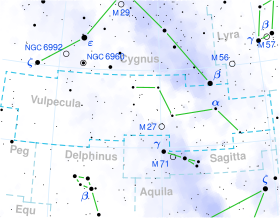23 Vulpeculae
| Observation data Epoch J2000 Equinox J2000 | |
|---|---|
| Constellation | Vulpecula |
| Right ascension | 20h 15m 46.13481s[1] |
| Declination | 27° 48′ 51.2787″[1] |
| Apparent magnitude (V) | 4.52[2] |
| Characteristics | |
| Spectral type | K3- III Fe-1[3] |
| U−B color index | +1.11[2] |
| B−V color index | +1.26[2] |
| Astrometry | |
| Radial velocity (Rv) | +1.47[4] km/s |
| Proper motion (μ) | RA: −34.27[1] mas/yr Dec.: +6.41[1] mas/yr |
| Parallax (π) | 9.63 ± 0.46 mas[1] |
| Distance | 340 ± 20 ly (104 ± 5 pc) |
| Absolute magnitude (MV) | -0.58[5] |
| Orbit[6] | |
| Primary | 23 Vul Aa |
| Companion | 23 Vul Ab |
| Period (P) | 25.33 yr |
| Semi-major axis (a) | 0.111″ |
| Eccentricity (e) | 0.400 |
| Inclination (i) | 71.5° |
| Longitude of the node (Ω) | 97.5° |
| Periastron epoch (T) | 2009.56 |
| Argument of periastron (ω) (secondary) | 293.8° |
| Details | |
| 23 Vul A | |
| Mass | 2.4[7] M☉ |
| Luminosity | 146[5] L☉ |
| Surface gravity (log g) | 0.89[8] cgs |
| Temperature | 4,429[9] K |
| Metallicity [Fe/H] | +0.03[5] dex |
| Rotational velocity (v sin i) | 3.7[10] km/s |
| Other designations | |
| Database references | |
| SIMBAD | data |
23 Vulpeculae is a triple star[12] system in the northern constellation of Vulpecula. It is visible to the naked eye as a faint, orange-hued star with an apparent visual magnitude of 4.52[2] and it is located approximately 340 light years away from the Sun based on parallax.[1] The system is moving further from the Earth with a heliocentric radial velocity of +1.47 km/s.[4]
Component A forms a binary system with an orbital period of 25.33 years, an eccentricity of 0.40, and a semimajor axis of 0.11″.[6] The 4.80 magnitude member of this pair, component Aa is an aging giant star with a stellar classification of K3- III Fe-1,[3] where the suffix indicates an underabundance of iron in the spectrum. This star has 2.4[7] times the mass of the Sun and is radiating 146[5] times the Sun's luminosity from its enlarged photosphere at an effective temperature of 4,429 K.[9] Its companion, component Ab, has magnitude 6.5.[6] The tertiary member, component B, has a separation of 0.26" and a magnitude of 6.94.[7][13][12]
References
- ^ a b c d e f Van Leeuwen, F. (2007). "Validation of the new Hipparcos reduction". Astronomy and Astrophysics. 474 (2): 653–664. arXiv:0708.1752. Bibcode:2007A&A...474..653V. doi:10.1051/0004-6361:20078357. Vizier catalog entry
- ^ a b c d Ducati, J. R. (2002). "VizieR Online Data Catalog: Catalogue of Stellar Photometry in Johnson's 11-color system". CDS/ADC Collection of Electronic Catalogues. 2237. Bibcode:2002yCat.2237....0D.
- ^ a b Keenan, Philip C.; McNeil, Raymond C. (1989). "The Perkins Catalog of Revised MK Types for the Cooler Stars". The Astrophysical Journal Supplement Series. 71: 245. Bibcode:1989ApJS...71..245K. doi:10.1086/191373.
- ^ a b Famaey, B.; Jorissen, A.; Luri, X.; Mayor, M.; Udry, S.; Dejonghe, H.; Turon, C. (2005). "Local kinematics of K and M giants from CORAVEL/Hipparcos/Tycho-2 data". Astronomy & Astrophysics. 430: 165. arXiv:astro-ph/0409579. Bibcode:2005A&A...430..165F. doi:10.1051/0004-6361:20041272.
- ^ a b c d Anderson, E.; Francis, Ch. (2012). "XHIP: An extended hipparcos compilation". Astronomy Letters. 38 (5): 331. arXiv:1108.4971. Bibcode:2012AstL...38..331A. doi:10.1134/S1063773712050015. Vizier catalog entry
- ^ a b c "Sixth Catalog of Orbits of Visual Binary Stars". United States Naval Observatory. Archived from the original on 2017-04-30. Retrieved 2017-06-02 – via Naval Oceanography Portal. Contains data from Hartkopf, W. I.; Mason, B. D.; Worley, C. E. (2001). Fifth Catalog of Orbits of Visual Binary Stars.
- ^ a b c Malkov, O. Yu.; Tamazian, V. S.; Docobo, J. A.; Chulkov, D. A. (2012). "Dynamical masses of a selected sample of orbital binaries". Astronomy & Astrophysics. 546: A69. Bibcode:2012A&A...546A..69M. doi:10.1051/0004-6361/201219774. Vizier catalog entry
- ^ Soubiran, Caroline; Le Campion, Jean-François; Brouillet, Nathalie; Chemin, Laurent (2016). "The PASTEL catalogue: 2016 version". Astronomy & Astrophysics. 591: A118. arXiv:1605.07384. Bibcode:2016A&A...591A.118S. doi:10.1051/0004-6361/201628497.
- ^ a b McDonald, I.; Zijlstra, A. A.; Boyer, M. L. (2012). "Fundamental parameters and infrared excesses of Hipparcos stars". Monthly Notices of the Royal Astronomical Society. 427 (1): 343–357. arXiv:1208.2037. Bibcode:2012MNRAS.427..343M. doi:10.1111/j.1365-2966.2012.21873.x.
{{cite journal}}: CS1 maint: unflagged free DOI (link) Vizier catalog entry - ^ De Medeiros, J. R.; Mayor, M. (1999). "A catalog of rotational and radial velocities for evolved stars". Astronomy and Astrophysics Supplement Series. 139 (3): 433. arXiv:astro-ph/0608248. Bibcode:1999A&AS..139..433D. doi:10.1051/aas:1999401. Vizier catalog entry
- ^ "23 Vul". SIMBAD. Centre de données astronomiques de Strasbourg. Retrieved 2019-05-26.
{{cite web}}: CS1 maint: postscript (link) - ^ a b Eggleton, P. P.; Tokovinin, A. A. (2008). "A catalogue of multiplicity among bright stellar systems". Monthly Notices of the Royal Astronomical Society. 389 (2): 869. arXiv:0806.2878. Bibcode:2008MNRAS.389..869E. doi:10.1111/j.1365-2966.2008.13596.x.
{{cite journal}}: CS1 maint: unflagged free DOI (link) Vizier catalog entry - ^ Mason, Brian D.; Wycoff, Gary L.; Hartkopf, William I.; Douglass, Geoffrey G.; Worley, Charles E. (2001). "The 2001 US Naval Observatory Double Star CD-ROM. I. The Washington Double Star Catalog". The Astronomical Journal. 122 (6): 3466. Bibcode:2001AJ....122.3466M. doi:10.1086/323920. Vizier catalog entry
External links
- 23 Vulpeculae on WikiSky: DSS2, SDSS, GALEX, IRAS, Hydrogen α, X-Ray, Astrophoto, Sky Map, Articles and images

